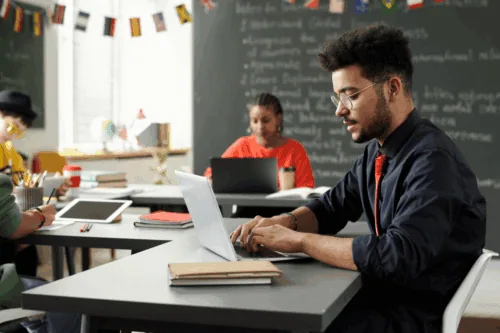Welcome to our comprehensive guide on equality in education. This resource is designed for anyone interested in understanding, promoting, and participating in educational equality. Whether you are an entry-level job seeker, educator, policymaker, or concerned citizen, understanding the facets of educational equality and how they impact our society is crucial.
Why Focus on Educational Equality?
Education is a cornerstone for personal and professional development in today’s rapidly evolving world. Ensuring fairness and equal opportunities in education paves the way for a more equitable workforce and society. This guide aims to unfold the various layers of equality in education and examine its current state, the barriers it faces, and strategies for improvement.
By the end of this guide, you will gain insights into how different stakeholders can contribute to this vital cause. Let’s explore how we can ensure everyone receives the education they deserve without disparities. Join us in this journey to delve deep into understanding and advancing equality in education.
Defining Equality in Education
Understanding equality in education is crucial to addressing its challenges and opportunities. This concept is often discussed yet widely misunderstood. Essentially, equality in education means providing every student with the same resources and opportunities to succeed, regardless of their background, social status, or economic conditions.
Critical Elements of Educational Equality
Several crucial components make up the foundation of educational equality:
- Access: All students must have equal access to learning materials, technology, and support services.
- Opportunity: Equal chances must be available to all students to participate in different educational programs and activities.
- Treatment: Equal treatment by teachers and administrative staff helps foster a supportive learning environment.
- Expectations: Teachers and institutions should hold consistent student standards and expectations.
Importance of Clarity in Definitions
Clarifying the terms related to equality in education helps stakeholders, from policymakers to educators and parents, work towards a common objective.
Proper understanding can drive better policies and practical measures that actualize the ideals of educational equality, thus fostering an environment where every student has an equal shot at academic success. For further reading on the operational definitions and the broader implications of these terms, consider the resources provided by educational institutions like Harvard University. As we delve deeper into the current state in the next section, the challenge becomes clear: achieving absolute equality in education requires first agreeing on what it means and how it should be measured.
Current State of Equality in Education
Examining the current state of education equality reveals progress and persistent disparities across various regions and demographics. Despite significant efforts to level the educational playing field, gaps in access, resources, and outcomes remain widespread.
National and Global Perspectives
In the United States, for example, students in low-income districts often receive less funding per student compared to those in wealthier areas, impacting the quality of education and resources available. Internationally, disparities are even more pronounced, with factors such as gender, economic status, and geographical location playing significant roles in educational access and quality. Organizations such as UNICEF provide in-depth analyses and reports on global educational inequality.
Technological Access and Inclusion
The rise of digital learning tools has introduced new challenges and opportunities in achieving educational equality. While technology can offer innovative learning methods and greater accessibility, it also risks widening the educational divide for students without reliable internet or technological devices. This digital divide is evident in both urban and rural settings.
Educational Outcomes
Data on educational outcomes, such as standardized test scores and graduation rates, frequently illustrate significant differences based on socioeconomic status and other demographics. These disparities highlight the ongoing challenge of ensuring all students have equal academic opportunities.
Addressing these issues requires concerted efforts and strategic policy implementation focused on equitable resource distribution and inclusive educational practices. The next section explores barriers to educational equality to better understand how to dismantle them effectively.
Barriers to Achieving Educational Equality
Understanding the obstacles to equality in education is vital for devising practical solutions. Several factors pose challenges to achieving educational equality across different communities.
Socio-Economic Disparities
Income levels greatly influence educational opportunities. Schools in wealthier areas often afford better facilities and more resources. Thus, students from lower socioeconomic backgrounds have disadvantages right from the start.
Cultural and Linguistic Challenges
Students whose first language isn’t the primary language of instruction often struggle academically. Additionally, cultural differences can affect student engagement and learning effectiveness.
Functional Needs Education
Providing adequate resources for students with disabilities remains a significant barrier. Often, these students do not receive the tailored support they require, impacting their educational progress.
Policy and Funding Inequities
Uneven funding distribution exacerbates educational disparities. Also, sometimes, policies do not equally address the specific needs of all student groups.
Addressing these barriers requires a multifaceted approach involving improved policy frameworks, inclusive educational practices, and enhanced community engagement. Next, we’ll look at strategies to encourage equality in education.
Strategies for Promoting Equality in Education
Several strategies can be implemented to address the barriers identified previously and enhance equality in education. These strategies are designed to promote inclusivity and access for all students.
Inclusive Curriculum Design
Developing curricula that reflect diverse cultures and perspectives ensures all students feel represented. This approach fosters a sense of belonging and increases engagement.
Equitable Resource Allocation
Ensuring that all schools receive fair funding and resources is crucial. Resources should be allocated based on the specific needs of each school’s student population.
Teacher Training and Support
Providing teachers with ongoing professional development in inclusive teaching practices is essential. This training helps educators effectively meet the diverse needs of their students.
Community and Parental Involvement
Engaging with communities and parents can enhance educational outcomes. This involvement helps tailor educational efforts to the specific needs of students.
Policy Reform
Advocating for and implementing policy changes at both local and national levels can address systemic inequities and create a more equitable educational landscape for all students.
Leveraging technology can also play a pivotal role in bridging the educational divide. Using digital tools and platforms, schools can extend learning opportunities beyond the classroom and reach underserved populations. In the next section of this article, continue exploring the impact of technology. For a deeper dive into policy reform, visit the U.S. Department of Education.
Role of Technology in Enhancing Educational Equality
Technology has a significant role in advancing equality in education. It offers innovative solutions that can help bridge the gap for underrepresented and disadvantaged groups.
Online Learning Platforms
These platforms provide access to quality education resources worldwide. They often offer free or low-cost options that are beneficial for low-income families. This accessibility supports educational equality by leveling the playing field.
Assistive Technologies
Assistive technologies enable students with disabilities to participate in standard educational activities. Tools like screen readers and speech-to-text programs are essential for their learning experiences.
Data Analytics
Using data analytics, educators can identify learning gaps and provide targeted interventions. This precision helps ensure that all students attain their fullest potential, irrespective of their background.
Furthermore, schools must ensure all students have the necessary technology and infrastructure to benefit from these tools. Partnerships with organizations like Internet Essentials can provide affordable Internet services to underprivileged communities, dramatically improving access to educational technology. For more information on combining policy and technology to enhance equality, visit the Edutopia website.
Legal Frameworks Supporting Equality in Education
Legal frameworks play a crucial role in enforcing and promoting equality in education. Various international and national laws provide the backbone for educational rights and ensure that these rights are uniformly applied.
International Agreements
The United Nations Convention on the Rights of the Child mandates that all children have the right to acquire an education without discrimination. This treaty is critical in guiding national policies worldwide.
U.S. Federal Laws
In the United States, the Individuals with Disabilities Education Act (IDEA) ensures students with disabilities can access free public education tailored to their needs. Similarly, Title IX prohibits sex-based discrimination in any education program receiving federal financial assistance.
Measures in the European Union
The European Union supports educational equality through directives and regulations that require member states to uphold the right to education and prevent discrimination.
These legal protections are essential for maintaining standards that support equality in education. They provide a recourse for grievances and set a standard that educational institutions must follow. For a deeper understanding of how these laws impact real-world policies, consider visiting educational resources from the American Civil Liberties Union. As we look toward evaluating the success of equality initiatives, the next section will peek into how the impact of these efforts can be effectively measured.
Measuring the Impact of Equality Initiatives
Assessing the impact of efforts to promote equality in education is essential for understanding progress and areas needing improvement.
Key Performance Indicators
Various KPIs can measure educational equality:
- Enrollment Rates: Increased diverse student enrollment showcases successful outreach and access initiatives.
- Graduation Rates: Higher graduation rates across all demographics indicate effective support systems.
- Achievement Scores: Improved test scores can reflect better educational equity.
Feedback Mechanisms
Surveys and feedback from students, parents, and teachers provide insights into the effectiveness of policies and practices. This feedback is crucial for continuous improvement.
Long-Term Studies
Longitudinal studies help track the lasting effects of educational reforms. They show how early educational interventions impact later life outcomes.
Transparent reporting and analysis ensure accountability and guide future strategies. By tracking these metrics, stakeholders can better understand the challenges and breakthroughs in achieving equality in education. Finally, sharing best practices and lessons learned encourages a collaborative approach to enhancing education for all, ensuring everyone can achieve their potential. The FAQs in the next section may address some common queries regarding the complexities and strategies related to educational equality.
FAQs
What is educational equality?
Educational equality means ensuring every student has the same resources and opportunities to succeed, regardless of background or circumstance.
Why is Equality in Education important?
It ensures all students can fulfill their potential and contribute to a fairer, more inclusive society.
How can technology improve educational equality?
Technology can provide accessible learning tools and resources, bridging gaps for underrepresented or disadvantaged students.
What role do governments play in promoting educational equality?
Governments can enact and enforce policies ensuring resources are allocated fairly, eliminating discrimination in educational settings.
Can small actions by individuals impact Equality in Education?
Yes, advocacy and volunteerism can drive change at local levels, influencing broader educational policies and practices.
How do we measure success in initiatives aimed at enhancing Equality in Education?
Improved enrollment, graduation rates, and equal achievement across all demographic groups measure success.
Conclusion
Advancing equality in education is crucial for creating a society where everyone has the opportunity to succeed. This concept encompasses access to resources, equal opportunities for learning, fair treatment, and supportive environments. While significant progress has been made, the journey towards true educational equality continues. We can progress towards this goal by addressing the barriers, effectively implementing inclusive strategies, and ensuring robust legal frameworks.
Take Action with Diversity Employment
To truly make a difference, involvement at all levels is necessary—from policymakers to educators and even individuals. Join us at Diversity Employment, where we champion initiatives that promote diversity and equality in the workplace and the educational sector. Together, we can contribute to a world where educational equality is not just an idea but a reality. Take the next steps in your diversity job search today towards building an inclusive future for the next generation!
Remember that equality in education is achievable with collective effort and persistent advocacy. Get involved, stay informed, and push for changes that ensure everyone has the same educational opportunities, regardless of background.




